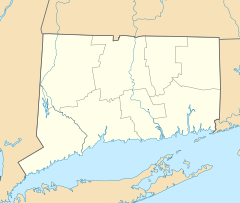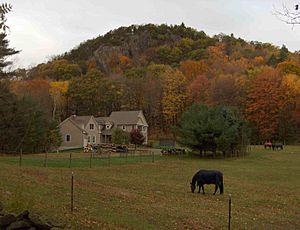McLean Game Refuge facts for kids
Quick facts for kids McLean Game Refuge |
|
|---|---|

Barndoor Hills Road entrance to McLean Game Refuge
|
|
| Location | Hartford County, Connecticut |
| Area | 4,400 acres (1,800 ha) |
| Established | 1932 |
| Designated: | 1973 |
The McLean Game Refuge is a huge nature preserve in Connecticut, covering about 4,400 acres (1,780 hectares). Most of this land is in Granby, with smaller parts in Simsbury and Canton. A man named George P. McLean, who was a Senator and Governor of Connecticut, bought all this land during his life. When he passed away in 1932, he left it to the McLean Fund, and it's still open for everyone to visit today. In 1973, a large part of the Refuge, about 1,800 acres (728 hectares), was named a National Natural Landmark.
History of the Refuge
George P. McLean started buying land for the Refuge in 1903. He had just finished his time as governor. In 1905, he received a large inheritance. He used this money to buy even more land, and he kept adding to his property until he died.
McLean's Public Service and Famous Visitors
In 1911, McLean became a Senator. He served three terms in this role. During his time as a senator, he helped pass an important law called the Migratory Bird Treaty Act of 1918. This law helps protect birds that migrate between countries. McLean often invited important political friends to visit his Refuge. These visitors included U.S. Presidents Coolidge, Taft, and Hoover.
Amos Everett George: The First Caretaker
In 1912, McLean met Amos Everett George. Amos was a Pequot Indian. He became the first caretaker of McLean's lands. Amos built many of the trails and small huts that you can still find throughout the Refuge today. His two sons later followed in his footsteps, also serving as caretakers.
The McLean Fund and Its Role
When George P. McLean died in 1932, he set up the McLean Fund. This fund was created to manage both the McLean senior living community and the Game Refuge. The McLean Fund has eight Trustees who oversee its operations. The McLean Fund still manages the Refuge today, making sure it remains a special place for nature and visitors.
Exploring the Refuge
Unique Geography and Landscapes
The McLean Game Refuge has a very interesting mix of land types. In the western parts, you can find old Paleozoic metamorphic rock. This kind of rock has been changed by heat and pressure over millions of years. In the east, there are trap rock ridges. These ridges were formed from volcanic rock during the Triassic period. They include parts of the Barn Door Hills, which are also part of the larger Metacomet Ridge.
Other areas of the Refuge are sandy plains. You can also see esker fields and kettle ponds. Eskers are long, winding ridges of sand and gravel. Kettle ponds are bowl-shaped hollows. Both of these were formed by melting glaciers during the Pleistocene period, which was a long time ago!
Two ponds, Trout Pond and Spring Pond, were created by building dams across creeks. East Barn Door Hill, which is 560 feet (171 meters) tall, is inside the Refuge. West Barn Door Hill, at 671 feet (205 meters), is in the nearby Granby Land Trust.
Hiking and Horse Trails
The Refuge offers more than 20 miles (32 kilometers) of hiking trails. There are also two trails specifically for horses. The Refuge has two main entrances and several other places where you can access the trails.
Archaeological Discoveries
In the 1990s, experts studied the McLean Game Refuge to learn about its past. They found important clues about how Native American people used this land long ago. This research helped us understand the history of the area.
Plants and Animals
Birdwatching Opportunities
The McLean Game Refuge is a fantastic place for birdwatching. Many different kinds of birds live here or visit. You might spot a pileated woodpecker with its bright red crest. Other common birds include the blue-headed vireo, winter wren, hermit thrush, and the colorful Blackburnian warbler.
Trees and Shrubs of the Refuge
The types of plants you see in the Refuge change depending on the land. Common trees include chestnut, oak, beech, birch, maple, and hemlock. You can also find shrubs like huckleberry, blueberry, and mountain laurel. Before George P. McLean bought this land, it was used for timber and charcoal. Because of this, many of the trees you see today are stump sprouts. This means they grew back from old tree stumps after the original trees were cut down.



